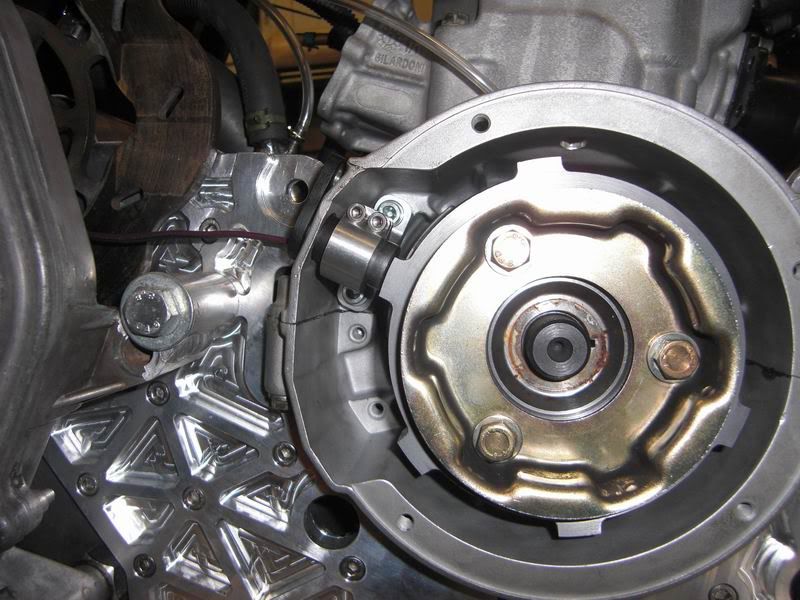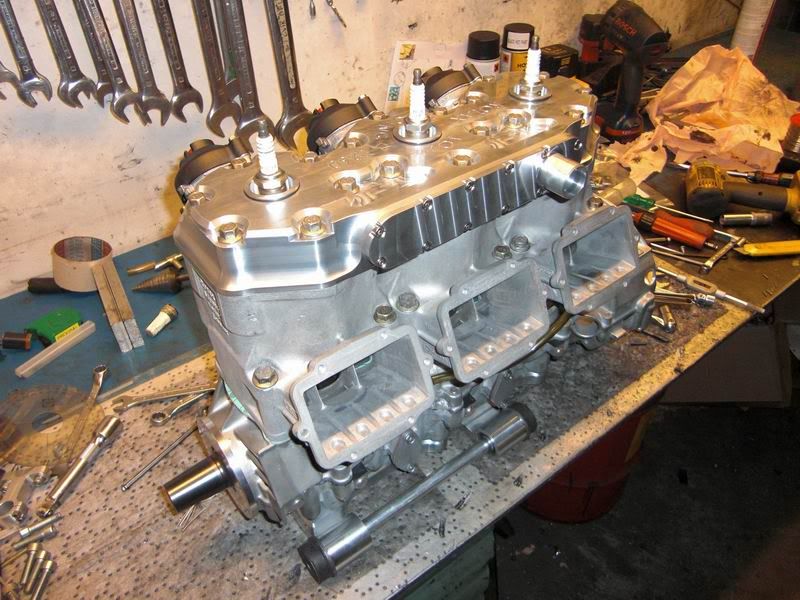Two Stroke Ignition
I helped a friend build an ignition system for his 3 cyl two-stroke engine last winter. It's for a snow mobile:
- 1260 cc, 200+ bhp (9000 rpm, idle 1500 rpm)
- Carburators
- M&W CDI ignition box (4 channnels, 3 used) with three M&W CDI coils
- http://www.youtube.com/watch?v=IES9tmpFWrs
We used a 6-1 trigger wheel with a Honeywell GT1 Hall sensor :

Here is the engine assembled, all machine work has been done by the owner/builder :

The only problem is starting it - our current method of triggering the ECU in combination with the pull start mechanism makes it tough!
It runs great once started, but it simply won't consistently fire the ignition while the engine has momentum from the pull start, and we suspect that this is due to the 6-1 trigger. Every pull only rotates the engine two turns which can be too little to sync the ECU quickly enough. Factory three cylinder snowmobile engines don't have this problem, of course many factory engines have electrical starters but this is not an option on most racing machines and there is very little room for it on this one since the chassis is originally made for a two cylinder engine, not three.
The stock ignition systems on these two strokes fire wasted spark, on every cylinder event, two cylinder engines do it all the time, and three cylinders at least while cranking/pulling. This is what we would like to do as well, but that will probably require a mix of changes in both the firmware and trigger system.
One plan we have come up with is this :
- Change the primary trigger to simple coiltype with three teeth (one for each cylinder event) and use it without cam sync only in "config A" while starting. This makes it possible to fire a single ignition output on each trigger event, that output connects to all three inputs on the M&W CDI box via diodes so that the three are only short-circuited at the ECU.
- There is no waiting to sync up with missing teeth or cam sync at this stage, the coils fire immediately and the engine should be much easier to pull start.
- There is a special mode to fire the ignition earlier and on this engine can gain 1/3rd rotation, it's only used on some kickstart bikes and only for coiltype trigger. When trigger pulse happens around 10-15 BTDC, spark can follow right away during cranking.
- Activated by igntdcdelay < actual ignadv AND low igntdcdelay configured (<40 deg IIRC, but probably only 6-15 deg makes sense).
- To avoid using up too much power in the ignition system, once RPM reaches 1000 rpm, we switch to config B which uses cam sync as well making it a 3+1 trigger. This time three other ignition outputs are used to fire the coils sequentially, isolated from the single ignition output in config A using diodes.
- In config A, a misc output grounds an analog input that activates the TableSwitch above 1000 rpm, so once the engine has started and has seen 1000+ rpm, it will run with cam sync and sequential ignition until it's turned off.
Fastest syncup with only 1 sectrig pulse
- leave primtrig=6-1 (that is 5 teeth numbered 0,1,2,3,4)
- apply a secondary trigger with falling edge ~30deg before tooth2 and rising edge ~30 deg before tooth4
- we could conceive a smarter sectrig pattern with more pulses that allows even faster sync. But going from 120 deg to 30-60 deg probably does not worth the extra effort
- Note that the MembersPage/YasecElise is the smartest sectrig-only pattern supported by VEMS: it allows half-rotation initial syncup. So if some fabrication is involved, it might be reasonable to make that (or something similar with less teeth if that many teeth cannot fit)
We don't know yet, but simply changing from a 6-1 missing tooth trigger to a 3+1 trigger could make starting significantly better. This is only speculation on my part (Mattias), my reasoning is that the ECU can fail to notice that it just passed the missing tooth, in case the crank rotation starts just before the missing tooth - resulting in a lost crank rotation before the ECU properly sees the missing tooth and starts firing the coils. With the 3+1 trigger the ECU will hopefully be more consistent and sync up properly every time.
Both 6-1 and 3+1 methods still (should) require one rotation to sync up, but 3+1 can be used to fire on each event using TableSwitch.
Thoughts:
- A higher tooth count than 6-1 would improve the situation by detect the missing tooth more consistently?
- yes, somewhat, but the MembersPage/YasecElise definitely helps
- Marcell does not recommend 3+1, that seems like a step back even from 6-1
Other suggestions from Marcell that needs more investigation:
- There used to be a "watch both edges while cranking" mode for sectrig. Might be useful for 3+1 type trigger.
- So long (HALL) sectrig pulse might help a lot.
- this mode wasn't used at all for ages, and needs retesting for sure
- This should be made into a special case in the triggerlog if possible
I will return to this page in a week or two with a triggerlog from cranking/pulling and an updated view on how easy it is to start with the most recent firmware (1.1.84+).